McKees Rocks, Pennsylvania
| McKees Rocks, Pennsylvania | |
| Borough | |
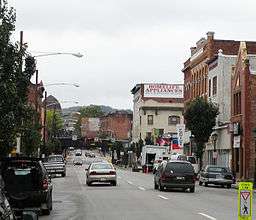 Chartiers Avenue, McKees Rocks, PA | |
| Official name: Borough of McKees Rocks | |
| Named for: Alexander McKee | |
| Nickname: The Rocks | |
| Country | United States |
|---|---|
| State | Pennsylvania |
| County | Allegheny |
| Coordinates | 40°28′12.79″N 80°3′49.22″W / 40.4702194°N 80.0636722°WCoordinates: 40°28′12.79″N 80°3′49.22″W / 40.4702194°N 80.0636722°W |
| Population | 6,104 (2010) |
| Settled in 1764 | Incorporated in 1892 |
| Timezone | EST (UTC-5) |
| - summer (DST) | EDT (UTC-4) |
| ZIP code | 15136 |
| Area code | 412 Exchanges: 331,771,777.778 |
| School District | Sto-Rox |
 Location in Allegheny County and the state of Pennsylvania | |
 Location of Pennsylvania in the United States | |
| Website: McKees Rocks | |
McKees Rocks, also known as "The Rocks", is a borough in Allegheny County, in western Pennsylvania, along the south bank of the Ohio River. The borough population was 6,104 at the 2010 census.[1]
In the past, the city was known for its extensive iron and steel interests. Also, there were large railroad machine shops, and manufacturers of locomotives, freight and passenger cars. Other city factories manufactured springs, enamel ware, lumber, wall materials, plaster, nuts and bolts, malleable castings, chains and forgings, tin ware, concrete, and cigars.
The Pittsburgh, Allegheny and McKees Rocks Railroad is located in an area along the river known as the "Bottoms".
The name of the borough is often incorrectly written as "Mc Kees Rocks," "McKee's Rocks," or "McKees Rock," but the official name is "McKees Rocks." The USPS official spelling is "MC KEES ROCKS".[2]
It is within the Sto-Rox School District, which serves McKees Rocks and neighboring Stowe Township. The local high school is Sto-Rox High School.
The McKees Rocks Bridge, which carries traffic between McKees Rocks and Pittsburgh, is the longest bridge in Allegheny County, at 7,293 feet (2,223 m). It has one of the largest Indian mounds in the state, built by the Adena and Hopewell peoples a thousand years before Europeans entered the area.
History
For thousands of years, Native Americans inhabited the region. The Adena culture built a large earthwork mound here, which was a burial site. It was augmented in later years by members of the Hopewell culture. This is the largest mound in the state. Exploration by people in the area in the late 19th century found that it contained the remains of 33 people. The mound is located on a promontory near the Ohio River; as a result, erosion has taken away some of the mound's property.[3]
This site was considered by George Washington as a possible location for Fort Pitt, which he eventually ordered built on the site of the destroyed French Fort Duquesne in what is now Pittsburgh's Point State Park.[4]
The borough derives its name from trader Alexander McKee, who also served as an Indian agent. He was given a 1,300-acre (530 ha) tract of land in 1764 for his services during the French and Indian War. The name also related to a rocky projection into the river at this site. In 1769, the name McKees Rocks was placed on an official deed,[5] and that year is considered to be its founding date.[6] In 1892, it was incorporated as a borough.[6] In 1900, 6,353 people resided in the borough; in 1910, 14,702; in 1920, 16,713; and in 1940, 17,021 people inhabited McKees Rocks. After industrial restructuring caused a loss of jobs in the city, the population declined, to 6,104 at the 2010 census.
Mann's Hotel, which was possibly one of the oldest buildings in the Pittsburgh area,[7] was located at 23 Singer Avenue in McKees Rocks. It was believed to have been built around 1803, although some sources put the construction in the 18th century.[7] It is rumored that George Washington stayed there[7] when he was surveying the Indian mound. On October 12, 2009, Mann's Hotel was condemned due to neglect and had to be demolished because of its deteriorating condition.[8][7]
McKees Rocks was the site of one of the pivotal labor conflicts of the early 20th century, the 1909 McKees Rocks Strike. In the summer and early fall of 1909, some 5,000 workers of the Pressed Steel Car Company's plant at McKees Rocks went on strike, joined by 3,000 others who worked for the Standard Steel Car Company of Butler and others in New Castle.[9] The strike, led by organizers of the Industrial Workers of the World (IWW), was repressed by armed security guards and the state militia, resulting in at least a dozen deaths. The conflict involved participants on both sides.[10]
The city hit its peak of population in 1930. After that, there was population decline due to the Great Depression, industrial restructuring and suburbanization after World War II.
Geography
McKees Rocks is located at 40°28′13″N 80°3′49″W / 40.47028°N 80.06361°W (40.470218, -80.063674).[11]
According to the United States Census Bureau, the borough has a total area of 1.1 square miles (2.8 km2), of which 1.0 square mile (2.6 km2) is land and 0.1 square miles (0.26 km2), or 6.31%, is water. McKees Rocks is made up of several neighborhoods, such as West Park, Meyers Ridge, and "The Bottoms".
Demographics
| Historical population | |||
|---|---|---|---|
| Census | Pop. | %± | |
| 1890 | 1,687 | — | |
| 1900 | 6,352 | 276.5% | |
| 1910 | 14,702 | 131.5% | |
| 1920 | 16,713 | 13.7% | |
| 1930 | 18,116 | 8.4% | |
| 1940 | 17,021 | −6.0% | |
| 1950 | 16,241 | −4.6% | |
| 1960 | 13,185 | −18.8% | |
| 1970 | 11,901 | −9.7% | |
| 1980 | 8,742 | −26.5% | |
| 1990 | 7,691 | −12.0% | |
| 2000 | 6,622 | −13.9% | |
| 2010 | 6,104 | −7.8% | |
| Est. 2015 | 6,010 | [12] | −1.5% |
| Sources:[13][14][15][16] | |||
As of the census[14] of 2000, there were 6,622 people, 2,905 households, and 1,652 families residing in the borough. The population density was 6,377.5 people per square mile (2,458.4/km²). There were 3,402 housing units at an average density of 3,276.4 per square mile (1,263.0/km²). The racial makeup of the borough was 82.71% White, 14.06% African American, 0.26% Native American, 0.68% Asian, 0.03% Pacific Islander, 0.41% from other races, and 1.86% from two or more races. Hispanic or Latino of any race were 1.09% of the population.
The census of 2010 revealed there were 6,104 residents. The population density was 6003.25 people per square mile. The racial makeup of the borough was 62.17% White, 35.26% African American, 0.57% Asian, and 0.34% from other races. Hispanic or Latino of any race were 1.65% of the population.
Households: There were 2,905 households out of which 26.0% had children under the age of 18 living with them, 29.4% were married couples living together, 21.3% had a female householder with no husband present, and 43.1% were non-families. 37.8% of all households were made up of individuals and 17.2% had someone living alone who was 65 or older. The average household size was 2.24 and the average family size was 2.96.
Age Distribution: The population included 24.1% under the age of 18, 7.8% from 18 to 24, 28.3% from 25 to 44, 20.9% from 45 to 64, and 19.0% who were 65 or older. The median age was 38. For every 100 females, there were 89.1 males; for every 100 females age 18 and over, there were 84.2 males.
Income: The median income for a household in the borough was $22,278, and the median income for a family was $29,063. Males had a median income of $25,872 versus $23,402 for females. The per capita income for the borough was $13,858. About 20.5% of families and 25.3% of the population were below the poverty line, including 38.8% of those under age 18 and 17.0% of those age 65 or over.
Points of interest
The multimillion-dollar, 40,000 sq ft (3,700 m2) Father Ryan Cultural Arts Center opened in 2008, at 420 Chartiers Avenue, adjacent to the F.O.R. Sto-Rox Library (at 500 Chartiers Avenue). It offers many creative and performing arts courses to the public.
The "Bottoms" neighborhood is the site of the McKees Rocks Indian Mound, designated as a National Historic Landmark. The oldest human bones in eastern North America have been discovered here during an excavation.
Surrounding and adjacent neighborhoods
Brighton Heights (Pittsburgh via McKees Rocks Bridge), Esplen (Pittsburgh), Kennedy Township, Stowe Township, Windgap (Pittsburgh)
Notable people


- Myron Brown, Slippery Rock University basketball star and NBA player
- Tom Clements, quarterbacks coach of the Green Bay Packers
- Chuck Fusina, Penn State, USFL, and NFL football player
- John Kasich, 69th Governor of Ohio since 2011, former Congressman, and presidential candidate in 2000 and 2016[17]
- Catherine Baker Knoll, 30th Lieutenant Governor of Pennsylvania (2003-2008)
- Carl Kosak, author
- Al Kozar, Major League Baseball infielder
- Ted Kwalick, Penn State all-America football player and San Francisco 49ers all-Pro tight end; member of the College Football Hall of Fame
- Bob Ligashesky, Sto-Rox graduate of 1985, tight ends coach for the Denver Broncos
- Billy Mays (1958-2009), television pitchman and Oxi-Clean spokesperson, known for his bearded face and distinct voice.[18]
- Jeff Smith, cartoonist, best known as the creator of the self-published comic book series Bone[19]
- Matthew Skoff, goaltender for Penn State Division I men's ice hockey
- Paul Spadafora, former IBF world lightweight boxing champion, known as the "Pittsburgh Kid"
- Olive Thomas, silent film actress, and the original flapper
In popular culture
McKees Rocks is the fictional setting of the novels Duffy's Rocks by Edward Fenton, Riot by William Trautmann, and more than a dozen novels by the crime writer K.C. Constantine.
See also
Gallery
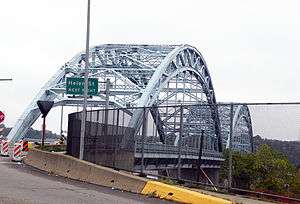 The McKees Rocks Bridge from Island Avenue
The McKees Rocks Bridge from Island Avenue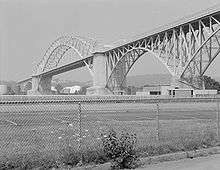 Another view of the McKees Rocks Bridge
Another view of the McKees Rocks Bridge Mancini's Bakery (since 1926)
Mancini's Bakery (since 1926) McKees Rocks Mound historical marker
McKees Rocks Mound historical marker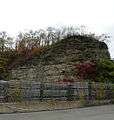 "The Rocks" of McKees Rocks
"The Rocks" of McKees Rocks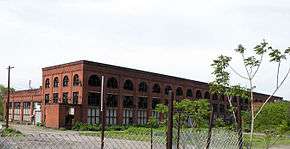
References
- ↑ "Race, Hispanic or Latino, Age, and Housing Occupancy: 2010 Census Redistricting Data (Public Law 94-171) Summary File (QT-PL), McKees Rocks borough, Pennsylvania". U.S. Census Bureau, American FactFinder 2. Archived from the original on September 11, 2013. Retrieved September 20, 2011.
- ↑ USPS.com® ZIP Code™ Lookup
- ↑ Pitz, Marylynne (2001-05-12). "Burial Mound to Get Historical Marker". Pittsburgh Post-Gazette. Retrieved 2008-11-05.
- ↑ Part I
- ↑ http://www.mckeesrocks.com/qa.jsp
- 1 2 http://www.pittsburghlive.com/x/pittsburghtrib/s_78303.html
- 1 2 3 4 Torsten Ove, "Historic Mann's Hotel will become history", Pittsburgh Post-Gazette, Saturday, August 08, 2009.
- ↑ Pittsburgh History & Landmarks Foundation, "Historic Mann's Hotel Demolished", PHLF News, 12 October 2009.
- ↑ Louis Duchez, "The Strikes in Pennsylvania," The International Socialist Review, vol. 10, no. 3 (September 1909), pp. 194-195.
- ↑ Marylynne Pitz, "Pressed Steel Car strike in McKees Rocks reaches centennial anniversary," Pittsburgh Post-Gazette, 16 August 2009, pg. E1.
- ↑ "US Gazetteer files: 2010, 2000, and 1990". United States Census Bureau. 2011-02-12. Retrieved 2011-04-23.
- ↑ "Annual Estimates of the Resident Population for Incorporated Places: April 1, 2010 to July 1, 2015". Retrieved July 2, 2016.
- ↑ "1990 Population and Housing Counts". US Census Bureau. Retrieved 22 November 2013.
- 1 2 "American FactFinder". United States Census Bureau. Archived from the original on September 11, 2013. Retrieved 2008-01-31.
- ↑ "Number of Inhabitants: Pennsylvania" (PDF). 18th Census of the United States. U.S. Census Bureau. Retrieved 22 November 2013.
- ↑ "Annual Estimates of the Resident Population". U.S. Census Bureau. Retrieved 22 November 2013.
- ↑ Henry J. Gomez (May 12, 2014) A mailman's son in McKees Rocks dreams of priesthood and politics: John Kasich 5.0 Cleveland.com
- ↑ Stacy, Mitch (2009-06-28). "TV pitchman Billy Mays found dead". FOX Toledo.com. TVL Broadcasting, Inc. Retrieved 2009-06-28.
- ↑ Biography: Jeff Smith. Scholastic. Retrieved July 23, 2013.
